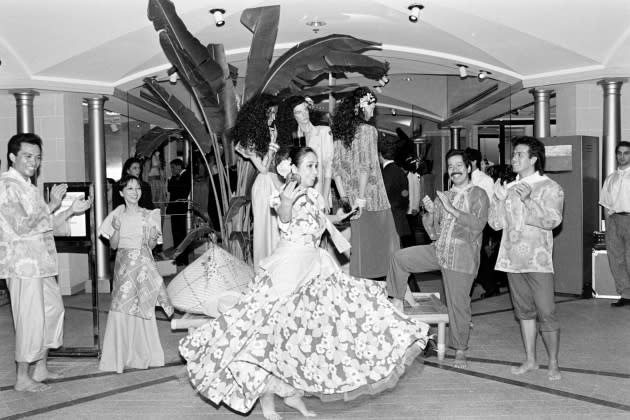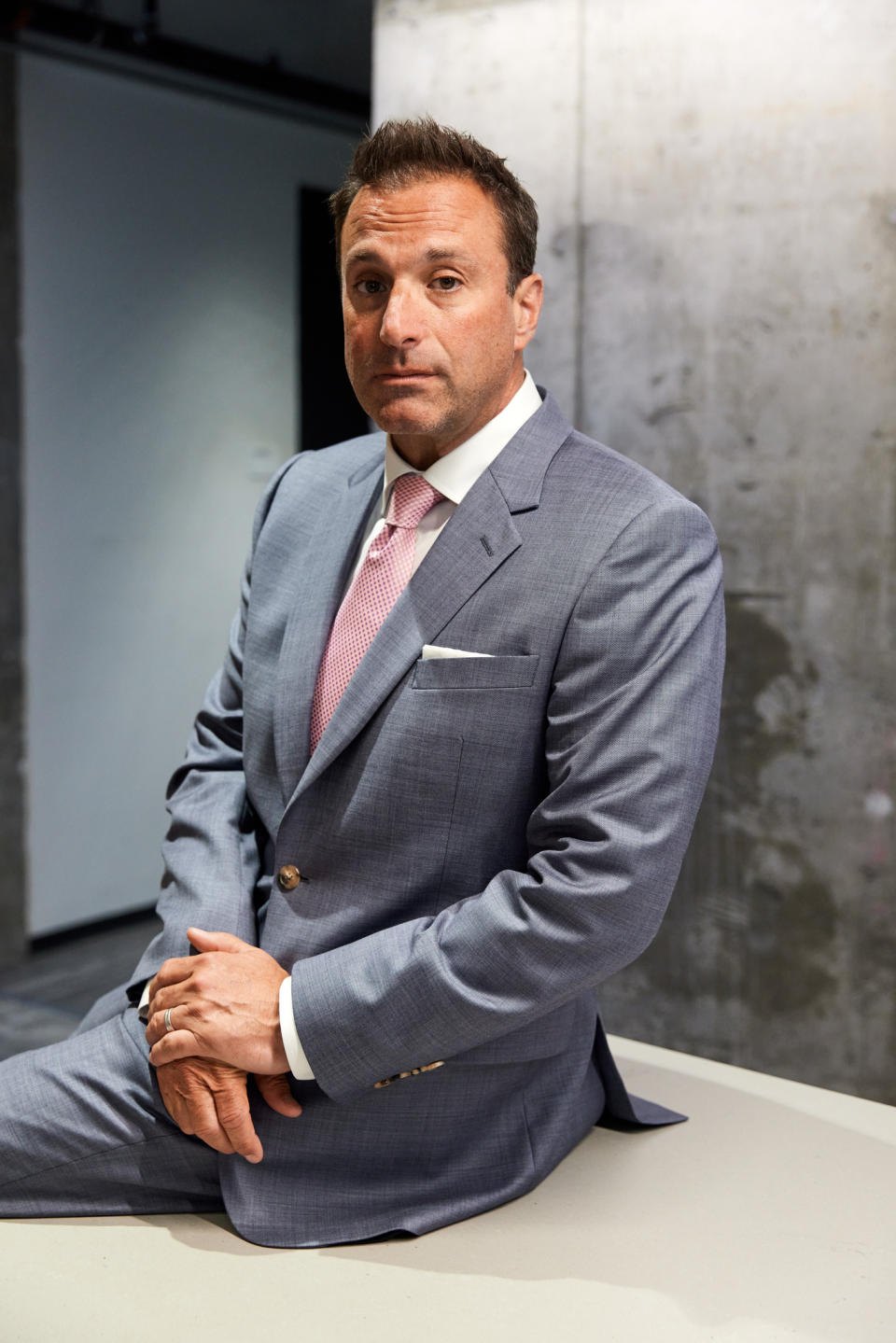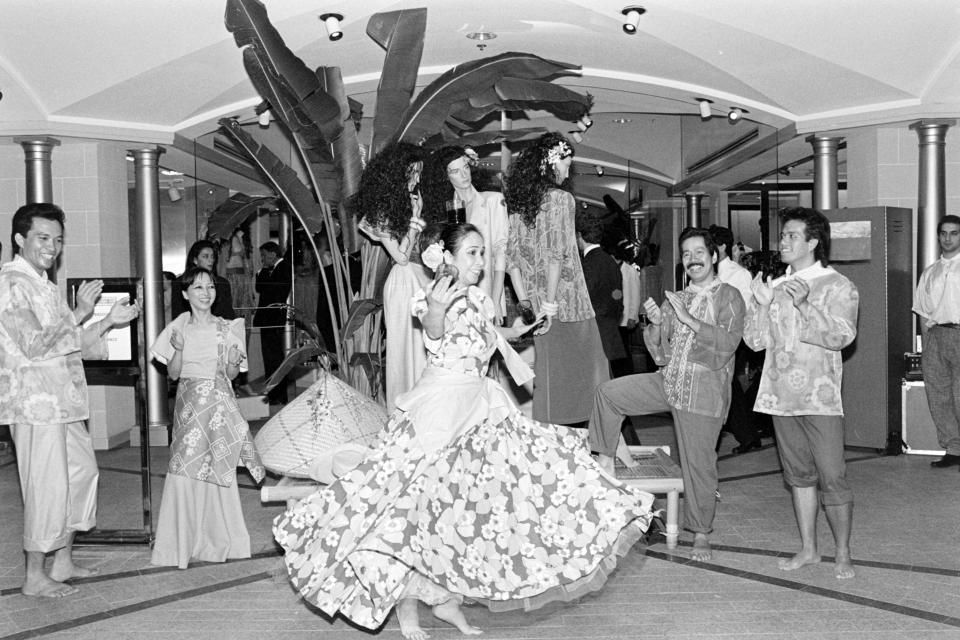The Store Was a Pioneer in Embracing Retail as Theater

From early guerilla marketing and elaborate country promotions to Broadway extravaganzas, Bloomingdale’s has been a pioneer in embracing “retail as theater.”
Although commonplace now, the department store was an early adopter of innovative marketing techniques — a strategy that continues today.
More from WWD
Retail as Theater: A Look Back at Bloomingdale's In-Store Events
Bloomingdale's On Screen: Movies and Television the Store Has Collaborated With
And the man who has been charged with carrying on that legacy is Frank Berman, executive vice president and chief marketing officer. Berman joined the company more than 30 years ago, working his way up from a business manager in the housewares department, through the merchant organization — he made lots of friends and even met his wife, as the food and candy buyer: “I had ungodly amounts of chocolate samples and caviar and was very popular,” he said — before joining the marketing department 23 years ago. He was named to the top post in 2008.
As the store started to prepare to celebrate its 150th anniversary, Berman scoured the archives to “chronicle Bloomingdale’s history as a brand — not so much as a business, but what it has meant to New York, fashion and pop culture in general,” he said.
What he found is that the original owners, the Bloomingdale family, were “the first to really go after guerilla marketing and outdoor advertising. It was unheard of then, but they bought 5,000 beach umbrellas that had Bloomingdale’s logos on them, and handed them out on Coney Island and all over the city promoting the fact that they had this fantastic bazaar on the Upper East Side.”
And they also took a “monstrous outdoor billboard” above the Polo Grounds, where the New York Giants, Yankees and Mets played in the early days. “They just were always thinking about how to get in front of the customer’s mind in a way that was unique and really broke through the clutter,” he said.
It was necessary, the family believed, because they had also chosen an unorthodox location for their store. While the rest of Manhattan’s carriage trade retail was downtown in the Ladies Mile (now the Flatiron District), founders Joseph and Lyman Bloomingdale opted for 938 Third Avenue. But what they realized, Berman said, was that this was where many of the New York City subway lines would converge and the Queensboro Bridge would open in 1909.
“At one point in the early 1900s,” Berman said, “they were the number-one advertiser in the city.” They were also among the first to install a “mobile walkway,” the precursor to the escalator, in 1898, and in the 1930s, used the windows in their newly opened flagship on 59th Street to showcase everything from Parisian fashions to knitting demonstrations. They supported women’s suffrage, organized fundraising events during the Great Depression, and the list goes on.

Masato Onoda/WWD
“They were always in touch with pop culture,” Berman said. “But what’s been so fascinating is our brand today is still as authentic to what the original family was thinking as when they launched their store.”
As far back as 1914, he said, Bloomingdale’s was advertising in the New York Evening Standard about how its merchant team was shopping the world and bringing innovative products back to its store in New York. “People were not traveling as they do today,” he said. “So this would become a fascinating place to come and discover new things that you really didn’t have access to as a consumer at the time.”
The family took advantage of every opportunity, he said, “to really get ahead of the curve” and address the way shopping was changing throughout the city. “At one point, they sold $2 million worth of self-playing pianos,” he said with a laugh. By the 1940s, after the Great Depression, “they saw prosperity coming and that’s when they started to get into the upscale merchandise and luxury realm and really begin that journey,” he said.
But they never lost sight that shopping needed to be a diversion to escape everyday life. “It’s buzzy for the last 10 years to talk about the retail experience, and we’re all competing for consumers and their social activities. But they really made shopping fun. It was a place to disappear for a couple of hours and discover things you never thought about.”
In 1947, they debuted the Model Rooms, featuring full-room vignettes. “Anyone can sell furniture, but they conceived of it in a way to capture the imagination,” he said.

Toni Palmieri/WWD
And then there were the now-legendary country promotions. “Our buying organization traveled around the world for six, seven weeks at a time, immersing themselves in China and other country cultures and bringing that back to the U.S. where throngs of people came to just discover, enjoy and shop. It was a very successful formula.”
Not surprisingly, the store has adapted to the times and today, it has the Carousel, a rotating pop-up shop under the direction of Kevin Harter, vice president of fashion, that changes every two to three months. The shops are dedicated to special moments in pop culture and have included “Bridgerton” and “Space Jam,” as well as designer-specific shops such as those for Stella McCartney and Marc Jacobs. In addition to curated assortments, the initiative generally includes window displays and in-store events.
“When you can bring that pop culture together with commerce that people are looking for, it’s a winning recipe,” Berman said. And while other retailers have abandoned such elaborate marketing pushes, Bloomingdale’s never has. “I can think of a lot of different companies who’ve had to change strategy. They didn’t keep up, they didn’t see where the trends were changing. But our consistent leadership and vision of what the brand stands for is aspirational. It’s welcoming for everyone. That was true back then, and it’s still true today.”
To celebrate its anniversary, the store is bringing its marketing to a whole other level. On its website, the store has built an extensive section that includes a look back at the history as well the opportunity to shop from its special 150th anniversary collection, along with “can’t miss” events.
“It’s a 360-degree experience that you’ll feel in all of our stores and our website,” Berman said. “We walk through the decades of the accomplishments of the store and with our partners, but it’s more about the direction we’re heading and how we are well positioned for future success. That’s one of our goals with this marketing effort: we want to capture the next generation of customer. We are a marketplace, a department store, that services generations of customers — multiple genders, across multiple families of business. And that has stood the test of time over the last 150 years. It’s a one-stop shop.”
The plan breaks down into three phases, Berman explained. A teaser campaign for the anniversary hit in August that ran through Sept. 7. But Sept. 8 marks the big launch when the exclusive merchandise will be revealed from more than 100 brands that have created some 300 pieces that incorporate the “iconic iconography of Bloomingdale’s,” he said, whether that’s the black-and-white check or the special paper used in the Big Brown Bag. “We let our partners imagine what their products would look like with a touch of Bloomingdale’s,” he said.
Among the brands that have participated are Ralph Lauren, Gucci, Balenciaga, Prada, Valentino, David Yurman, Maison Francis Kurkdjian, Byredo and others.
The product will be merchandised at the 59th Street flagship as well as in the Carousel space and will also be sold at all the branch stores and online. “It’s not exclusive for the sake of being exclusive but it is truly special, fantastic merchandise,” he said.
Then on Sept. 9 is a “huge gala” that will be held in partnership with Harper’s Bazaar in the 59th Street store where over 1,000 guests will be invited to celebrate the store’s birthday. There will be old arcade games including skeeball and claw machines, photo booths and a special performance by Jack Harlow.
But for those unable to attend in person, the event is being simulcast and hosted by entertainment journalist Lola Ogunnaike.
The festivities will continue through the holiday season as all of the stores in the fleet will be hosting events to celebrate the 150th. “We’ve got something happening every month on a large scale that’s inclusive of merchandise,” he said.
Philanthropy also plays a big role. The store is launching “Be the Change,” where Bloomingdales will raise funds and awareness for causes including sustainability, mental health, the Breast Cancer Research Foundation, No Kid Hungry, the Child Mind Institute and other charities.
Online, a virtual store is being created in partnership with Emperia, which is playing off the store’s tagline: Like No Other Store in the World. It’s being called: Like No Other Store in the Metaverse, where customers can shop for the 150th-anniversary merchandise. “You can wander around the space, engage with the merchandise and purchase it directly. Then there are also just fun things like a room of discovery which will surprise and delight, we’ve got a little Forty Carrots frozen yogurt shop set up, you get to ride the futuristic subway train around the store. So it’s a city in the clouds, it’s us imagining, again, the future of where Bloomingdale’s might head for the next generation of customers over the next 100 years.”
Executing such marketing efforts today is different from when the Bloomingdale brothers were handing out beach umbrellas. Competing retailers also want exclusive product and social media has made it difficult to stay at the forefront of pop culture.
Berman doesn’t disagree. “When I think about my first 15 years of Bloomingdale’s, there was one-way communication with customers, you sent them direct mail, they couldn’t talk back. We were a voice of authority along with the magazines of the day. Fast forward to today with the iPhone, social media — there has been a democratization of influence — and people want instant gratification. So to break through the clutter, you have to be much more clever and provide value for the customer.”
He and his team are “voracious readers of everything that’s happening,” whether that’s NFTs or Broadway shows such as “Hamilton” or “Hairspray.” “We’ve had Broadway Nights at 59th for 10 years, bringing different shows into the store and then having our customer be able to purchase products related to it.”
Most recently, the store created an extravaganza around “The Greatest Showman,” with Zendaya, who starred in the film, creating a special collection under its Aqua private label, which sold out in two and a half weeks, he said.
“All those different elements: product and entertainment, and the opulent and experiential nature of it lends itself to success.”
Looking to the future, Berman said he can’t fathom what life will be like in 150 years, but he believes Bloomingdale’s has the staying power to be around. “We will remain authentic and true to our brand, because what’s important today will still be important tomorrow,” he said. “Customers expect a great experience when they’re engaging with your brand, whether that’s in our stores, online, or in the metaverse. What I love hearing from customers is they love getting lost in our stores and on our site, it is really retail therapy. It’s the sum of all the ingredients that just leaves them wanting to come back for more. That’s a real position of privilege that we don’t ever take for granted and want to protect for generations to come.”
Launch Gallery: Retail as Theater: A Look Back at Bloomingdale’s In-Store Events
Sign up for WWD's Newsletter. For the latest news, follow us on Twitter, Facebook, and Instagram.
RSVP for "A Matter of Style", a Fairchild Archive exhibition September 9-10 in New York City.

